The second Battle of Franklin Tennessee in late November of 1864 took its toll on the citizens of Franklin. Many had offered their homes as hospitals for the wounded, while others had assisted with the burial of the dead. Few, however, made the sacrifices that the McGavock family of Carnton Plantation had.
Hundreds of dead had been brought to Carnton following the battle. Wounded men were placed on the Greek Revival porches of the sumptuous Carnton home, slave quarters were turned into makeshift hospital tents, and the grounds of the home were populated with tents holding injured soldiers, while others still were laid on the grounds themselves. Colonel John McGavock and his wife Carrie saw to the welfare of around 300 men in their own home-turned-hospital. Carrie McGavock and her children tended the wounded, even assisting in surgery. For months after the battle, convalescing soldiers remained in the McGavock home, recuperating under the care of the McGavock family.
Carnton’s grounds were soaked with blood, as was the house; the nursery, which had been turned into an operating room, was stained with blood thereafter.
The thousands of men who perished during the Battle of Franklin had posed a difficult problem for the residents of Franklin. Federal troops had buried their dead two to a grave near the Federal breastworks; however, most of their dead were moved, either by family members who took them to their own cemeteries or by the military, who reinterred them at the Stones River National Cemetery in Murfreeseboro.
The Confederate dead met a different fate. Almost all of the approximately 1,750 Confederate dead had been identified and buried shortly after the battle, their graves marked with wooden markers that listed the name, rank, regiment and company of the soldier. Most of these men were buried at on two local farms.
By 1866, these makeshift graveyards were deteriorating. The wooden markers were becoming illegible, and some had been stolen from the graves. However, there was another, more pressing problem – the land on which these men had been laid to rest was desperately needed for farm land.
The McGavocks donated two acres of the property at Carnton as a permanent cemetery for the Confederate dead. Along with the citizens of Franklin, the McGavocks raised money to exhume and re-inter nearly 1,500 of these soldiers to the land they’d set aside for the cemetery. A local many named George Cuppert was hired for the job, his pay $5.00 for each soldier moved.
Cuppett, his brother Marcellus, and two others spent ten weeks in the spring and summer of 1866 on the task of moving these graves. Marcellus, who died during the process, was buried in the new cemetery. George Cuppett kept the information about each soldier moved in a cemetery book, which he turned over to Carrie McGavock after the process was complete.
After the establishment of the cemetery, Carrie McGavock dedicated the remainder of her life to caring for the cemetery, corresponding with family members of the dead who were buried there, keeping records of the identities of those in the cemetery, and seeing to it that the cemetery did not fall into disrepair.
McGavock and her dedication to the cemetery gave her both national prominence and a national identity – “the Widow of the South.” Her renown was such that when Oscar Wilde visited the U.S. in 1882, he insisted upon visiting “sunny Tennessee to meet the Widow McGavock, the high priestess of dead boys.”
After the death of Carrie McGavock, the plantation house at Carnton began to deteriorate. However, the cemetery remained a local concern, and the Franklin Chapter of the United Daughters of the Confederacy has maintained the cemetery since 1905, the year of McGavock’s death. By the late 1970s, Carnton Plantation was nearly condemnable due to its advanced state of disrepair, but in 1978, the Carnton Association was formed to care for and restore the home. Today, it is a museum, on the National Register of Historic Places, and is open to the public, who can see the Widow of the South’s home and her book of the dead.



[…] Carnton Plantation and the “Widow of the South” – the True Story, pt. 2 […]